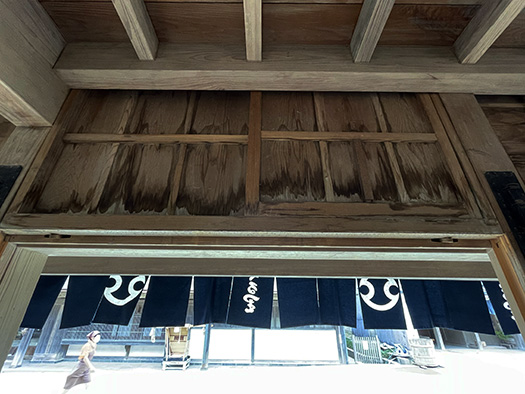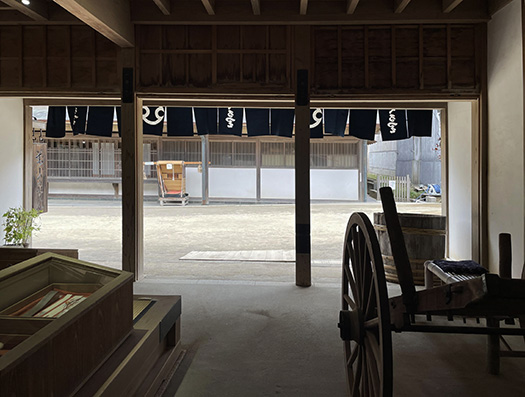

さて房総のむら「小間物屋くる里」さんシリーズ。主要な扱い商品としての髪結い関連製品、櫛・かんざしなどの「小間物」を見てみたが、本日は店舗の建築面の機能性について。
商家・町家は人通りのある街道筋などに対して間口を開けてその開口部はフルにオープンして顧客の誘導を図るのが一般的。2階建ての場合、1階は商品展示スペースとして活用して2階を商談専用、あるいは高額商品などのスペースとして利用する。ただし、その業態によって千差万別に対応が分かれていく。この小間物屋の場合、玄関間口は3間となっている。京町家など商家に対しての税は、間口の広さに相応して決められていたという。従って商家では間口が狭く、奥行きが長いという形式が多くなる。税負担軽減の知恵と工夫(笑)。それと密集感が「にぎわい」を自然に醸し出すので意図的にそうしていたのだろう。織田信長はかぶき者としてこうした町家群をぶらつく習性があったと言われる。重商主義的な権力の性格はこのような町家群の空気感が好みである権力者によってもたらされた。
ショーウィンドウとしての1階スペースがフルオープンで開放されるためには開口部建具は省略したいけれど、夜間などは閉めておきたいということで、シャッターのような機能を木製建具に担わせたい。ということからご覧のような「揚戸」「上げ下げ戸」という夜用出入口付きの木製シャッター。


さらに面白いのが荷車とショーケース的な台車。はじめこの車を見たとき、ひょっとして髪結いを終えた良家の奥方・令嬢がその姿を帰り道にこれみよがしに町の人に披露するパレード用のクルマか?と誤解したのですが(笑)、説明をしっかり見ると、どうやらタバコの煙管などの出店販売用のものとのこと。煙管の導管部のことをラオと言うそうで、これは「ラオ車」でキセルの販売やヤニ落とし修理などの行商に使った。そうするとこの1階の店舗三和土(たたき)部分は一種の駐車場でもあったワケで、それこそ昭和に至るまでの町家店舗の原型としての姿が浮かび上がってくる。
実際に昭和中期の戦後社会でわたしの生家ではこの台車の代わりに「オート三輪」車で配送・行商活動を行っていた。駐車場は実際には店の前の空き地を使っていたけれど、まさに商家の生き様の「つながり」を強く感じさせられて懐かしい。日々の営業活動に必死に取り組んで余念がなかった父母の日々の様子が強く香り立ってくる。取り扱う商品は違っても、日本の商家の基本のありようがピンナップされている。時代劇ドラマなどではサムライが主役だけれど、圧倒的多数の庶民はこのような暮らし方で連綿と今日社会まで生き延びてきているのだ。
English version⬇
Wooden shutters and delivery wagons, a contrivance of a merchant house, Edo period, Boso Machiya-7
Desperate for business, the front of the store was fully opened as a show window. Wooden fittings were constructed with wisdom and ingenuity, and a mobile car for peddling was also stored. The shop was built with wisdom and ingenuity.
Now, let’s take a look at the Boso no Mura “Komono-ya Kururi” series. We have looked at their main products, such as hairdressing-related products, combs, and ornamental hairpins, but today we will look at the architectural functionality of the store.
Generally, merchants’ houses and townhouses open their frontage to busy streets and other areas and fully open their frontage to lead customers in. However, the response will vary in a thousand ways depending on the type of business. In the case of this komomono shop, the front door has a 3-ken entrance. Taxes on merchant houses, such as Kyoto townhouses, were determined according to the size of the frontage. Therefore, merchant houses often have a narrow frontage and a long depth. This is wisdom and ingenuity to reduce the tax burden (laugh). The dense feeling of the building naturally creates “liveliness,” so it must have been done intentionally. Oda Nobunaga is said to have had a habit of hanging around these clusters of town houses as a kabuki actor. The heavy mercantilist character of power was brought about by the airy atmosphere of these machiya clusters by a few powerful men.
In order to fully open the first floor space as a show window, we wanted to omit the opening fittings, but we also wanted to close them at night, so we wanted the wooden fittings to function like shutters. This is why the wooden shutter with a nighttime entrance called a “lift door” or a “raised door” was designed, as you can see.
What is even more interesting is the cart and the showcase dolly. When I first saw this car, I mistakenly thought that it was a parade car for the wives and daughters of good families who had finished getting their hair done to show off their appearance to the townspeople on their way home (laugh). (Laughs) However, a closer look at the description reveals that it is a vehicle used to sell tobacco pipes and other items at tobacco stalls. The conduit part of a smoking pipe is called a “rao,” and this was a “rao car” used for peddling kiseru (tobacco pipe) for sale and repairing burnt tobacco. The first floor of the store was also used as a kind of parking lot, and this is the prototype of the machiya store that existed until the Showa period (1926-1989).
In fact, in the postwar society of the mid-Showa period, my family used an “auto three-wheeler” instead of this cart for deliveries and peddling. Although we actually used the vacant lot in front of the store for parking, it was a nostalgic experience that gave me a strong sense of “connection” in the way of life of a merchant family. The daily activities of the father and mother, who were desperately engaged in their daily sales activities, strongly remind me of their daily life. Even though the products handled are different, the basic way of being of a Japanese merchant family is pinned down. Samurai are the main characters in historical dramas, but the overwhelming majority of ordinary people have survived in this way of life for a long time until today.
Posted on 1月 14th, 2023 by 三木 奎吾
Filed under: 「都市の快適」研究, 住宅マーケティング







コメントを投稿
「※誹謗中傷や、悪意のある書き込み、営利目的などのコメントを防ぐために、投稿された全てのコメントは一時的に保留されますのでご了承ください。」
You must be logged in to post a comment.